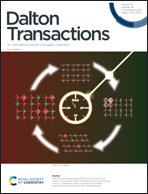Synergistic effect of a triethanolamine-modified carbon-based layered double hydroxide for efficient removal of nitrate from micro-polluted water†
Abstract
Owing to the ubiquitous existence and low concentrations of detrimental nitrogen pollutants in micro-polluted water, simple adsorption-oriented approaches are becoming increasingly appealing for the effective removal of NO3− from wastewater. Triethanolamine (TDA) modified carbon-based layered double hydroxide (LDH) composites (TDA@LDH/CS) were synthesized by a supersaturated co-precipitation method for efficient NO3− adsorption. The characterization results showed that TDA@LDH/CS, formed by the stacking of irregular nanosheets and lamellar aggregates, has a mesoporous structure and a specific surface area of 67.15 m2 g−1. The Langmuir and pseudo-second-order kinetic models were well fitted with the adsorption of NO3− by TDA@LDH/CS, with the maximum adsorption capacity reaching 14.45 mg g−1, and the adsorption process was consistent with the spontaneous exothermic entropy increasement. Furthermore, the synergistic adsorption mechanism of NO3− by the TDA-modified materials was proposed using XPS analysis, which indicated that TDA modification greatly enriched the surface of TDA@LDH/CS with tertiary amine groups (R3N) and hydroxyl groups (–OH), providing more adsorption sites and active sites. After five cycles, the NO3− removal rate could still reach 64.2%, which exhibited its high potential to be utilized as an adsorbent for the removal of nitrogen pollutants from micro-polluted water.



 Please wait while we load your content...
Please wait while we load your content...